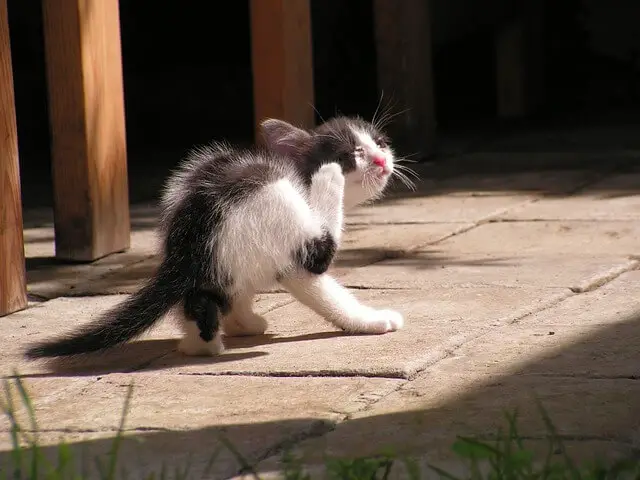What Is Hot Spot On Cats?
03.01.2023.
A hot spot is a synonym for recurrent episodes of acute moist dermatitis, often with pyotraumatic lesions. The main cause of dermatitis and self-trauma is allergic pruritus.
What is a hot spot?
Hot spot lesions are well-demarcated areas of erythema, alopecia, and moist dermatitis with proteinaceous exudate in the center of the lesion. Hair on the lesion margins sticks to exudative areas. These lesions tend to be painful.
A hot spot occurs when an animal traumatizes an area to alleviate pain or pruritus. The self-trauma can be triggered by many things, including allergic disorders, ectoparasites, otitis externa, hair mats, and musculoskeletal disorders.
Causes of hot spot
The most common cause of hot spots is flea allergy dermatitis. Other predisposing factors include hot weather and a dense hair coat.
This self-induced trauma causes
- Alopecia
- Inflammation
- Exudation
- Erosion
- Ulceration

Hot spot lesions then become secondarily colonized with bacteria, most commonly S. intermedius. Hot spots have an acute onset and can occur within several hours.
They form when cats bite, lick, or scratch excessively at certain body parts, which causes skin inflammations.
There is no breed, sex, or age predisposition for developing hot spots, but it is most common in cats with flea infestation or with a history of allergies.
Hot spots are frequent in warm and humid weather but then are also common seasonal allergies such as
- Pollen
- Grass
- Trees
- Fungus
Besides that, any allergy can trigger obsessive scratching and other parasites, such as ear and skin mites.
Symptoms of cat hot spot
The first symptom owner may notice compulsive scratching, licking, biting, or grooming. Obsessive and compulsive scratching often leads to self-trauma and consequently forms skin lesions. Skin becomes red, warm, and inflamed. Lesions often ooze. By the time lesions become crusty.
Most common symptoms of hot spot in cats include:
- Obsessive scratching, biting, licking, grooming
- Self-trauma
- Alopecia, exudation, erosion, ulceration
- Skin inflammation
- Crusty skin
- Hair loss or matted hair
- Pain
Diagnosing hot spots in cats
Hot spots are usually easy to diagnose by physical examination of the skin. The cause or underlying issue is more challenging to diagnose to prevent future hot spot formation. Sometimes your vet may do some parasitological research or dermatologic exams such as microscopy of the skin sample.

Treatment and prevention
Treatment of hot spots includes wound treatment and cause treatment. Wound treating includes clipping and cleaning the inflamed area. Removing exudate and debris with a mild antiseptic such as chlorhexidine or povidone-iodine is necessary.
The main goal is to stop self-trauma. This requires identifying and eliminating the underlying cause of pruritus and pain.
Cause treating includes flea control for cats with flea allergy dermatitis. Other treatments for hot spots include prescribing a topical medication containing both an antibiotic and a mild steroid. Some cats have good responses to low doses of prednisone. To prevent further self-trauma, an Elizabethan collar may be necessary.
In some cases giving antihistaminic drugs before seasonal allergy may help. The prognosis depends on the self-trauma level, but the appearance of the hot spot is usually repeated. Hot spot lesions can sometimes be colonized by secondary bacteria and may lead to pyoderma.
Conclusion
Recurrent moist dermatitis lesions are called hot spots. Lesions are usually painful, red, and warm, and the skin is inflamed. On the lesion margins, hair is usually damaged, and the affected area is hairless.
The main cause of developing hot spots is self-trauma triggered by allergies or parasites, which causes obsessive scratching. Skin becomes red, warm, inflamed, and crusty. The lesion is often secondarily colonized by bacteria such as S. Intermedius and leads to pyoderma. Diagnosis of hot spot lesions usually is enough physical examination, but it is necessary to exclude parasites such as ear mites or fleas, which are the most common cause of allergic dermatitis.
Treatment includes wound treatment by clipping hair and cleaning with antiseptics and cause treatments such as anti-flea or antihistaminic drugs. Supportive therapy for eliminating scratching can be topical ointment containing antibiotics and mild steroids or systematically giving prednisone and/or antibiotic pills. The Elizabethan collar is indicated to prevent self-trauma. The hot spot is not a deadly disease but is often recurrent and may lead to pyoderma.
World Cat Finder Team







Share